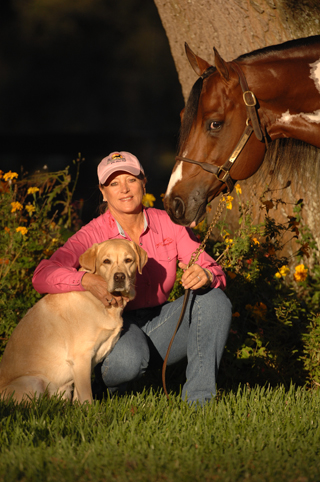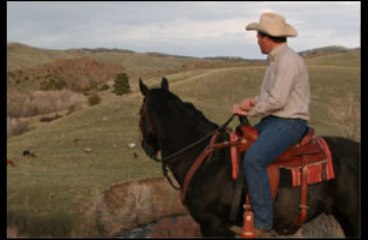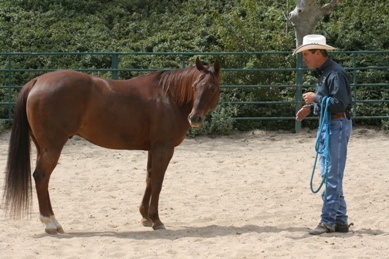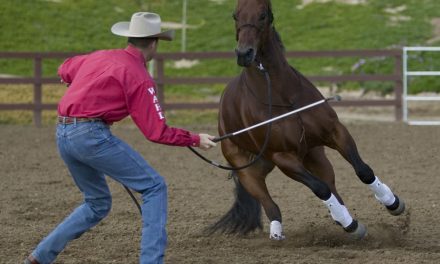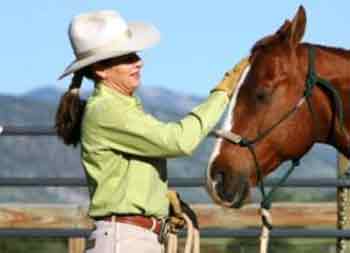Palm Partnership Training
Get Results You Can Use!
 We have previously discussed important steps to prepare for training on the trail, including reading the horse to recognize his inner energy level and working with him to release it, preparing the rider through warm up and stretching exercises, and building safety and confidence out on the trail.
We have previously discussed important steps to prepare for training on the trail, including reading the horse to recognize his inner energy level and working with him to release it, preparing the rider through warm up and stretching exercises, and building safety and confidence out on the trail.
There are three common types of problems riders encounter when training on the trail. They are: the horse always wanting to be in front, a horse running up behind a horse in front, and spookiness or a “hot” horse. This week, I will share trail training tips for the first of these situations- the horse who always wants to be in front.
The horse that always wants to be the “leader of the pack” usually has experience being on trail rides with other horses. He is showing his tendency to be the leader. A horse may show this characteristic as early as his first trail ride. It will become more and more of an issue the more trail rides he goes on, unless his rider learns how to deal with it.
A horse that is inexperienced at trail riding or who is in his earliest stages of trail training will be the easiest to train to accept whatever spot on the trail the rider wants to put him in. The key to this training is: the more often the rider changes the horse’s position on the trail ride, the more the horse will accept the rider’s commands and allow his natural instincts to take care of his rider. Here are two training methods to accomplish this training goal.
Single File Trail Training…Set up a trail ride training scenario where you and your horse are among several horse/rider combinations in head-to-nose line. Start with your horse in the lead position for a short time, about 2-3 minutes. Then shift positions in the line-up so he is the second horse. Stay in this position for a short time, then move him back to the lead. Continue leading for another short interval, then shift to be the third in line. Hold here for a while, then take him back up to the second position. From second position, rotate into fourth position for another short segment, then back to third, and so on.
Always start in the lead position. If he is in front, the horse should start to relax in about 2-3 minutes, then move him to a different position in the lineup. If he does not relax, rotate him within the trail ride line up anyway.
Pairs Trail Training…Once you have practiced rotating him within a single file line, ask riders to pair up so they are riding two-abreast down the trail. Bring your horse to the lead position with another partner horse and rider. He should begin to relax. Stay in the lead position 2-3 minutes, then with your partner, rotate into the second position in line. Again, if he does not relax, move him anyway. Stay in the new position for 2-3 minutes, then rotate to different positions within the line. Continue changing positions throughout the ride.
There are other techniques you can use to keep your horse’s attention on you when you are on a trail ride, including:
Leg Yielding…In a head-to-tail line, ask the horse to leg yield the right side of the trail by using your left leg aid. Once at the trail’s right edge, go forward, then yield back the other way. Do these maneuvers in short segments and be sure to repeat in both directions.
Transitions… To go along with short segments of yielding, mix in simple transitions in the trail ride to teach the horse to keep his interest and attention on you. Examples of simple transitions to incorporate include: walk to trot; trot to walk; walk to lengthening walk, trot to lengthening trot to slow trot. The emphasis of this training is based on the theory that the more the rider does short segments, changes the horse’s position, rides in pairs, yields, and does simple transitions; the more the horse concentrates on the rider rather than following his herd instincts.
Stopping is always a good option if the horse starts to get anxious while training on the trail. If he is jigging around when you are asking him to stop, get off. Spend some time with him on the ground until he relaxes. When he relaxes, get back on and resume the trail training process. What if he doesn’t relax? He is telling you that he has inner energy that needs to be released. He was not prepared enough for the lesson. You may need to walk him back to the barn; especially if the situation is making you fearful, nervous, or frustrated. Use the time going back to the barn to do in-hand maneuvers such as turn on the forehand, turn on the haunches, backing, and leg yielding. They will help him learn to focus more of his attention on you.
While practicing these trail training lessons, keep these safety precautions in mind:
1. When riding with a group, even with only one other person, always call out to the other rider(s) what you are going to do or designate one person on the ride to call out each short segment. One person should designate what others are going to do and announce it so everyone is ready for it.
2. When riding in a head-to-tail line, keep at least 1-horse length distance, (8-10 feet) between horses. When riding in pairs, respect the same distance between partners and the horses in front. Most trails are too narrow to allow this distance between riding pairs. Therefore, it is important riders learn to read their horse’s ears and body language to determine if he accepts the other horse and rider close to him.
3. Keep the 1-horse length distance rule, especially on trails where turns do not allow the horse in back to see the horse in front on him. A horse will not always accept this situation and will naturally want to run to be within sight of the horse in front. It is good trail etiquette for a rider in the lead to slow down around a turn to allow the rider behind them to stay 1-horse length behind. The rider who is behind should ask the rider in front to slow down to keep the leading horse within view of her mount.
Your Next Step…
This trail training lesson gives you these training benefits:
1. It encourages the horse to accept working in many different spots on the trail and with small groups of horses and riders.
2. It develops the horse’s concentration and focus on his rider’s commands.
3. It encourages the rider to work on his or her ability to function as a thinking rider and the horse to respond to the rider’s aids and commands while developing a partnership and harmony between them.

